![]()
![]()
![]()
Use LEFT and RIGHT arrow keys to navigate between flashcards;
Use UP and DOWN arrow keys to flip the card;
H to show hint;
A reads text to speech;
70 Cards in this Set
- Front
- Back
|
Major Acquisition Activities |
1. Pre-systems Acquisition 2. Systems Acquisition 3. Sustainment |
|
|
Pre-Systems Acquisition |
Work efforts during this period are prior to there being a formal Acquisition program. 1. Materiel solution analysis (Milestone A) 2. Technology development (Milestone B) 10% of costs |
|
|
Systems Acquisition |
1. Engineering and Manufacturing Development (Milestone C) 2. Production and Development 30% of costs |
|
|
Initial Capabilities Document |
Broad, time phased, operational goals, and a description of the required capabilities to address a specific gap. |
|
|
DoD Acquisition Life Cycle |
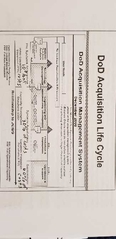
|
|
|
Sustainment |
1. Operations and support. Fully operational capability is achieved 60% of costs |
|
|
Acquisition Phases |
1. Materiel Solution Analysis 2. Technology Development 3. Engineering and Manufacturing Development 4. Production and Deployment 5. Operation and Support |
|
|
Milestone A |
One path into the Acquisition process begins with examining alternative concepts to meet a stated mission need. This path starts with a decision at Milestone A to authorize entry into the Technology Development phase. Normally, successful passage of Milestone A does not equal program initiation for a new program. |
|
|
Milestone B |
The purpose is to authorize entry into the Engineering and Manufacturing Development phase. Usually the point at which program initiation occurs. At this point, the military Department or agency is required to have adequate funds in the FYDP to finance the Acquisition program during this period. |
|
|
Milestone C |
A favorable decision authorizes the program manager to commence low rate initial production or limited Deployment. |
|
|
Acquisition Categories |
Established to determine the level bnb of management review, decision authority, and applicable reporting requirements for a program. |
|
|
ACAT 1 Programs |
1. Major Defense Acquisition Program 2. Estimated by USD (AT&L) to require total expenditures of: -RDTE of more than $365M or -Procurement of more than $2.19B 3. Estimated by USD (AT&L) because of special interest (Congress, complex Technology, joint program) 4. Dollar Estimate to include cost of all known evolutionary Acquisition blocks. |
|
|
ACAT 1 Subcategories |
ACAT 1D: MDA is at DoD level ACAT 1C: MDA is at Component level |
|
|
ACAT 1A |
1. A Major Automated Information System program 2. USD (AT&L) estimates costs to require: -total cost in any single year in excess of $32M -total program cost in excess of $126M or -total life Cycle cost in excess of $378M |
|
|
ACAT 1A Subcategories |
-ACAT 1AM: MDA is at DoD level -ACAT 1AC: MDA is at Component level |
|
|
Analysis of Alternatives |
Primary purpose is to assess the potential materiel solutions to satisfy the capability need documented in the approved Initial Capabilities Document. Key product of the Material Solutions Analysis phase of the Acquisition process. |
|
|
Analysis of Alternatives Study Guidance |
Prepared by Director, CAPE |
|
|
Cost Analysis Requirements Description - CARD |
1. Required for all ACAT 1 and ACAT 1A programs 2. Updated for all Milestone and program reviews 3. Prepared by program manager 4. Identifies detailed requirements of Acquisition system: -technical requirements -programmatic data -operational characteristics -assessment of risks and mitigation efforts 5. Forms basis for preparation of cost estimates |
|
|
Life Cycle Cost Estimates |
1. Appropriation Category 2. Work Breakdown Structure 3. Life Cycle Cost Categories -R&D -Investment -operations and support -Disposal |
|
|
ACAT 1 Life Cycle Cost Estimates |
1. Program Office Estimate 2. Component Cost Estimate 3. Independent Cost Estimate |
|
|
Program Acquisition Unit Cost |
Total cost for development and procurement and MILCON divided by the number of fully configured end items to be produced for the Acquisition program. |
|
|
Average Procurement Unit Cost |
Total of funds programmed to be available for obligation for procurement by the number of fully configured end items to be procured. |
|
|
Life Cycle Cost Composition |
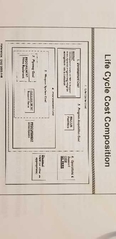
|
|
|
Work Breakdown Structure |
Product oriented family tree composed of hardware, software, services, data and facilities that displays and defines the product to be developed and/or produced. It relates the elements of the work to be accomplished to each other and to the end product. |
|
|
Cost As An Independent Variable |
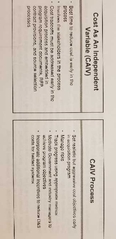
|
|
|
Cost Estimating Methods |
1. Analogy 2. Parametric 3. Engineering 4. Actuals 5. Expert |
|
|
Analogy Cost Estimating Method |
1. Based on direct comparison with historical information of similar existing activities, systems, or Components 2. Compares proposed new system with ONE existing similar system for which there is accurate cost and technical data. 3. Strengths: quick, inexpensive, easy to change 4. Weaknesses: subjective, imprecise |
|
|
Parametric Cost Estimating Method |
1. Known as statistical or top down method 2. Based on physical attributes or performance characteristics and their relationship to highly aggregated component costs. 3. Uses database of elements from similar systems. 4. Uses multiple similar systems 5. Most beneficial in earlier stages of the system or life cycle. 6. Strengths: uses cost Estimating relationships, easy to do what if drills, relatively inexpensive 7. Weaknesses: moderately subjective, precision only as good as the validity of data evaluated |
|
|
Engineering Cost Estimating Method |
1. Known as bottom up method 2. Requires extensive knowledge of system characteristics 3. Each WBS element is costed to build the cost estimate for the entire program. 4. Strengths: very accurate, limited subjectivity 5. Weaknesses: very expensive and time consuming, difficult to do what if drills, usually performed by contractors |
|
|
Actual Cost Estimating Method |
1. Actual cost data of SAME system 2. Strengths: little subjectivity, very accurate 3. Weaknesses: limited applicability, budget may already be submitted |
|
|
Expert Opinion Cost Estimating Method |
1. Subjective judgment of an experienced individual or group 2. Use if time does not permit a more thorough analysis 3. Document source of Opinion of experts 4. List attributes of the source 5. Seek convergence with Delphi Technique |
|
|
Delphi Technique Cost Estimating Method |
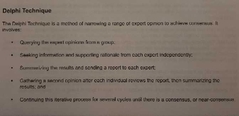
|
|
|
Fixed price contracts |
Contractor bears significant financial risk. |
|
|
Cost reimbursement contracts |
The government promises to pay all allowable, allocable, and reasonable costs incurred on the contract. The government bears a potential significant financial risk. |
|
|
Earned Value Management |
An integrated tool that relates technical performance to its associated cost and schedule, measures the work progress in objective terms, and states the value of the work completed in dollars. Used to measure contractor performance. |
|
|
EVM on DoD Contracts |
1. Applicable for cost or incentive contracts valued at $20M or more. 2. For such contracts valued at less than $20M, its use is optional and a risk based decision for the government. 3. Contracts at $50M or more, contractors system must comply with guidance. 4. Discouraged for firm fixed price contracts of any dollar value |
|
|
Cost variance |
Result of comparing Actual Cost of Work Performed to the Budgeted Cost of Work Performed. |
|
|
Schedule Variance |
Result of comparing the Budgeted Cost of Work Scheduled to the Budgeted Cost of Work Performed. |
|
|
EVM Analysis |
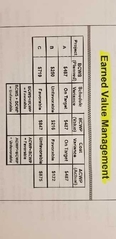
|
|
|
Critical Path |
Longest possible continuous path from the start event to the terminal event. |
|
|
Economic Analysis |
1. Systematic approach to the problem of choosing the best method of allocating scarce resources to achieve a given objective. 2. Each alternative must be considered and its life cycle costs and benefits evaluated. 3. All costs and benefits are adjusted to present value. |
|
|
Economic Analysis Model |
1. Establish objective 2. Formulate assumptions 3. Identify constraints 4. Determine/identify alternatives 5. Estimate costs and benefits of each alternative 6. Compare alternatives 7. Perform sensitivity analysis 8. Report results and recommendations |
|
|
Quantifiable Benefits |
1. Cost savings 2. Cost avoidance 3. Productivity improvement |
|
|
Cost Savings |
Result in the actual reduction of an approved program if the benefit occurs during the POM period. |
|
|
Cost Avoidance |
A reduction or elimination of some future resource requirement. |
|
|
Productivity Improvement |
A reduction in future personnel time and effort requirements associated with a function or assigned task that has been included in an approved program. |
|
|
Non-quantifiable Benefits |
Adaptability Availability Functionality Maintainability Morale Security Upgradability Versatility |
|
|
Descriptive Statistics |
Do not project or imply anything outside the specific data set. Most common types include: 1. Measures of central tendency 2. Measures of dispersion 3. Frequency distribution 4. "Skewed" distribution |
|
|
Measures of Central Tendency |
Mean Median Mode |
|
|
Measures of Dispersion |
Range Standard Deviation |
|
|
Frequency Distribution |
Histogram/bar chart Frequency polygon |
|
|
Inferential Statistics |
Methods used to examine a sample of a population and make inferences about the entire population based on analysis of the sample data. 1. Proportion and Percentage 2. Measures of Correlation |
|
|
Constant Dollars |
The result of having the effects of inflation removed. |
|
|
Current Dollars |
Then-year dollars are expressed in the value of the year in which a cost is expected to occur, and therefore reflect the effect of inflation. |
|
|
Break-even Point |
Investment÷Savings |
|
|
Business Process Reengineering/Business Process Innovation |
1. Goal is to improve operating Effectiveness by redesigning the fundamental processes of the organization. 2. Involves a radical redesign of key business processes rather than incremental actions. |
|
|
Business Process Reengineering Steps |
1. Create a Reengineering framework 2. Identify customers and determine needs 3. Map the existing process 4. Measure process performance 5. Redesign the existing process 6. Implement the design |
|
|
Reengineering Team Composition |
1. Best to keep under 10 players. 2. Those who dont know process 3. Those who know process well 4. Customers, if possible 5. Some representing impacted organizations 6. Technology gurus 7. Best and brightest 8. Some from outside Organization |
|
|
Lean Six Sigma Continuous Process Improvement |
1. Define 2. Measure 3. Analyze 4. Improve 5. Control |
|
|
Benchmarking |
1. Measuring performance against the best in class Organization 2. Adapting best practices 3. Achieving new performance levels |
|
|
Government Performance and Results Act Purposes |
1. Improve confidence in capability of federal government 2. Initiate program performance reform 3. Improve federal program Effectiveness and public accountability 4. Help federal managers improve service delivery 5. Improve Congressional decision making 6. Improve internal management of the federal government |
|
|
Government Performance and Results Act (GPRA) Modernization Act of 2010 Agency Strategic Plan |
Expanded the original purposes of GPRA to include a strategic plan which must address: 1. Short but comprehensive mission statement 2. Outcome oriented long term goals and objectives 3. Performance goals and how they will be met 4. Federal priority goals if assigned to the agency |
|
|
GPRA Modernization Act of 2010 - Agency Performance Plan |
1. Defines the level of performance to be achieved during the submittal year and the next FY. 2. May be used to structure the agency's budget submission or be a separate document that accompanies it. |
|
|
GPRA Modernization Act of 2010 - Agency Performance Report |
1. Annually required to be posted to the agency's website no less than 150 days after the end of the FY. 2. Provides agency's progress in achieving goals and objectives described in the Strategic plan and performance plans. |
|
|
Outcome Measures |
Assessment of the qualitative results of a program activity when compared to it's intended purpose |
|
|
Output Measures |
Anything produced by an organisation that can be tabulated, calculated, or recorded and can be expressed in a quantitative or qualitative measure |
|
|
Input |
All processes and Resources used to accomplish short-term goals and outcomes. Usually can be evaluated in monetary terms. |
|
|
Miscellaneous sources of funds |
- Agricultural and grazing leases - Recycling -sale and out-lease - fish and wildlife conservation program -energy savings at military installations |
|
|
Outsourcing |
Responsibility remains with government: 1. Contracts 2. Franchises 3. Volunteers |
|
|
Privatization |
Responsibility shifts from government: 1. Family housing 2. Utilities |

